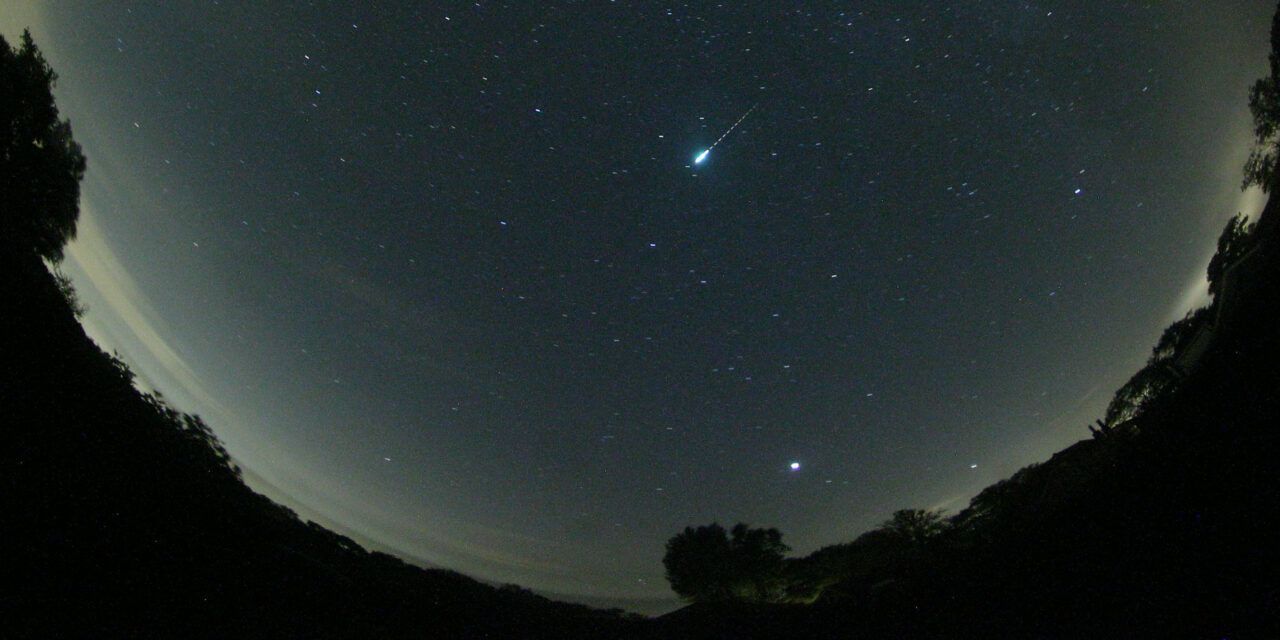Koen Miskotte, Carl Johannink and Hans Betlem
Dutch Meteor Society, the Netherlands
Abstract
The kappa Cygnids (KCG#012) showed increased activity in 2021 as predicted. This article describes the results of the calculations on the visual observations of the kappa Cygnids. However, during this analysis a number of important and critical questions arose, which the authors have tried to answer by using data from CAMS networks.
1 Introduction
Every year around the Perseid maximum, slow meteors can be seen with sometimes a characteristic (end) flare or multiple flares (see Figures 1 and 2). These meteors seem to come from an area roughly between Vega and kappa Cygni, the kappa Cygnids. The meteor shower was first observed by Miklós Konkoly-Thege of the Ó-Gyalla Observatory in Hungary in 1874 (Kronk, 1987). The famous meteor observer William F. Denning gave the name to this meteor shower in September 1893 (Denning, 1893). He noticed that the shower displayed higher activity in some years than in others. In 1954 it was proven that the kappa Cygnids were a real meteor shower: Fred Whipple published orbital elements of 5 kappa Cygnids photographed multi-station (Jenniskens, 2006). The meteors had an orbital period between 7 and 8 years.
2 Recent history
In 1985 Koen Miskotte, together with Robert Haas, Arjen Grinwis and Bauke Rispens (members of team Delphinus from Harderwijk) were able to observe the kappa Cygnids under good conditions from Puimichel, Southern France (Miskotte, 1985). Relatively large numbers of kappa Cygnids were seen there, the hourly counts increased to 8 on the night of August 18–19. Quite a few bright kappa Cygnids were also seen, but only one fireball. In 1986 observations were done again from Puimichel (Miskotte, 1986), but lower numbers of kappa Cygnids were seen, up to 5 in one hour during the night August 14–15. In 1986, most of the time there were more faint kappa Cygnids compared to 1985. In 1993 a major DMS multi-station campaign was organized in the Provence in Southern France to observe the expected Perseid outburst of August 12 (Langbroek, 1993). During these observations, the activity of the kappa Cygnids was also remarkable, for example some kappa Cygnid fireballs of –8 and twice a –6 were observed and photographed, see Figure 2. A maximum ZHR of 3 was found from visual data (Jenniskens, 2006, figure 24.8, p. 444). Based on these (photographic) observations, among other things, Peter Jenniskens concluded that the possible parent body of the kappa Cygnids could be the asteroid 2008 ED69 (Jenniskens et al., 2008).
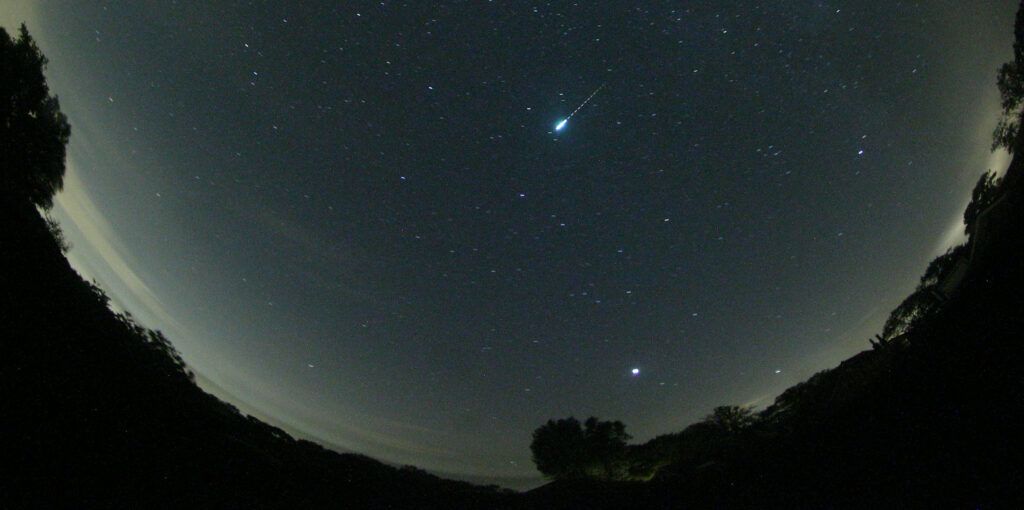
Figure 1 – A beautiful picture from Oostkapelle, the Netherlands. Klaas Jobse captured this nice kappa Cygnid in Pegasus on August 16, 2021.
The photographic magnitude of the final flare was magnitude –14.
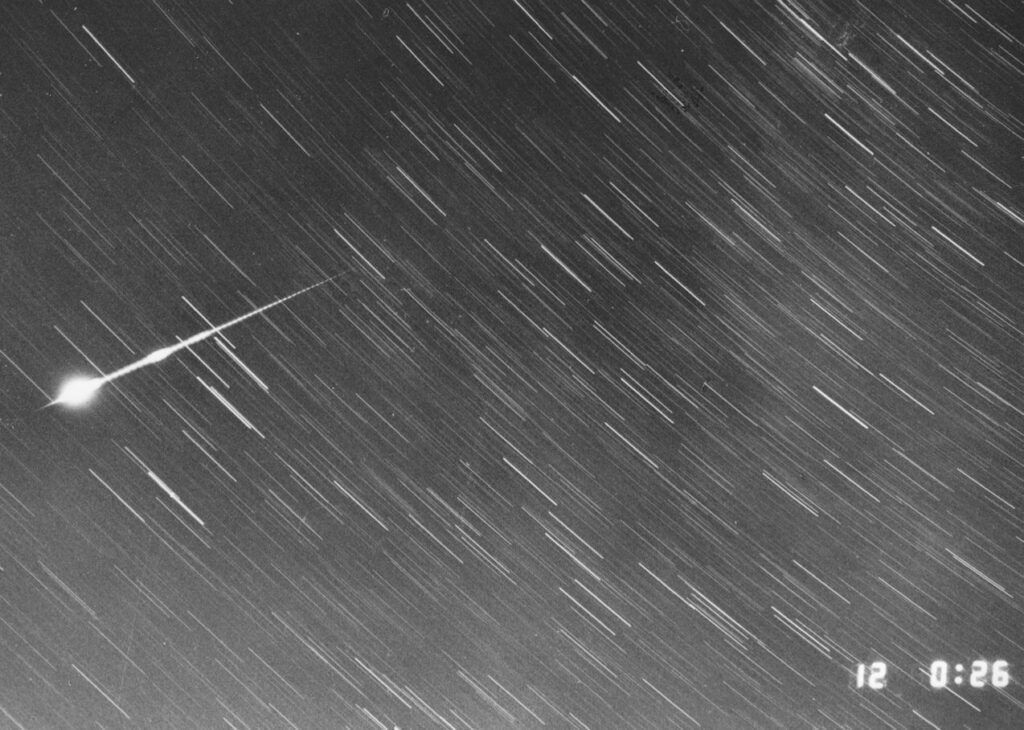
Figure 2 – This beautiful kappa Cygnid was captured during the Perseid outburst of August 12, 1993 from Rognes in southern France.
Photo: Team Delphinus, Rognes, South of France. Camera: Canon T-70 with commando back and a Canon 50 mm F 1.8 lens.
In 1999, during the Perseid maximum, a number of kappa Cygnid fireballs were observed and in 2007 again enhanced kappa Cygnid activity has been observed. The activity was very good with a number of fireballs. For example, two kappa Cygnids (–4 and –6) were photographically captured by the authors during a Perseid campaign near the German
town of Grevesmühlen (Johannink, 2007; Jenniskens et al., 2007). Also in 2014, more kappa Cygnids were seen than normal (Rendtel et al., 2015). During the years with normal kappa Cygnid activity, the ZHR is around 1. In years with increased activity, the ZHR varries between 3 and 6.
3 The kappa Cygnids in 2021
As a result of the observations from 1985, 1993 and 2007, it was already expected that the kappa Cygnids would be again more active in 2021. This was confirmed on August 9, 2021 in CBET 5014 by Peter Jenniskens (Jenniskens, 2021a). In a publication on MeteorNews (Jenniskens, 2021b), Peter Jenniskens states that CAMS observations showed that the kappa Cygnids had been active since the end of June. During that time, the radiant moved from the Antihelion position to Lyra around August 8. In addition, the radiant is stretched out up to 15 degrees in declination during each night. See also Figure 3.
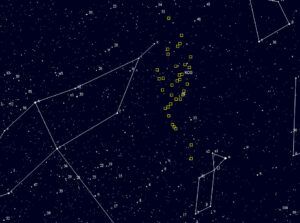
Figure 3 – The radiants (yellow squares) found of paired kappa Cygnids recorded by the CAMS-BeNeLux network on the night of 2021 August 10–11.
After the successfully completed chi Cygnid (minor shower) analysis in 2020 (Miskotte, 2020; Miskotte, 2021) the first author decided to make an analysis of the kappa Cygnids in 2021 based on visual observations. However, a number of critical questions arose during the analysis that will be discussed in more detail later.
4 Population index r
We could download the visual data from the website of the International Meteor Organization for our analysis. In order to be able to make a ZHR calculation, the population index r had to be calculated. To be useful, the observations had to meet the following criteria:
- The minimum limiting magnitude had to be 5.9.
- The difference between the limiting magnitude and the average magnitude of the observed meteors should not exceed 4 magnitudes.
- The population index r is determined per night or per range of nights.
|
Day |
Tm (h) |
λʘ (°) |
KCG |
r[–1:5] |
|
6 |
23.83 |
134.425 |
18 |
1.9 ± 0.62 |
|
8 |
1.07 |
135.433 |
11 |
2.05 ± 0.84 |
|
8 |
23.60 |
136.333 |
24 |
1.8 ± 0.52 |
|
9 |
23.80 |
137.301 |
58 |
2.72 ± 0.3 |
|
10 |
23.33 |
138.241 |
62 |
3.15 ± 0.29 |
|
11 |
23.60 |
139.212 |
137 |
2.25 ± 0.18 |
|
13 |
1.90 |
140.264 |
129 |
2.76 ± 0.18 |
|
14 |
2.20 |
141.236 |
79 |
2.53 ± 0.25 |
|
15 |
3.30 |
142.241 |
30 |
2.64 ± 0.45 |
|
16 |
3.30 |
143.202 |
45 |
1.76 ± 0.35 |
|
24 |
0.00 |
150.767 |
30 |
2.27 ± 0.45 |
Table 1 – Population index r on magnitude range [–1;5] for the kappa Cygnids in August 2021.
The time mentioned, Tm is the average time of all observation periods used in the calculations of the population index r.
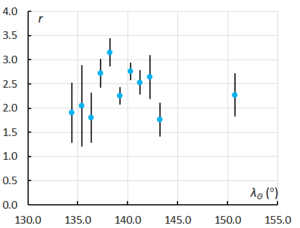
Figure 4 – Population index r of the kappa Cygnids in 2021 based on Table 1. Some observers reported seeing no kappa Cygnid fireballs in 2021, while others did.
The BeNeLux all sky network captured 5 maybe even 7 kappa Cygnids simultaneously with a photographic magnitude of –6 to –14 (Betlem, 2021).
The period 1 to 6 August had too few kappa Cygnids to determine a reliable population index r. The population index r could be calculated per night for the period from 6 to 17 August, but again there was too little data for the following period (moonlight!). The result of the calculations on the magnitude range from –1 to +5 shows a very variable population index r per night. The results are shown in Table 1 and Figure 4. The r-value for August 24 is the result of an r-value calculation based on all data from the entire period from August 17 to 31 inclusive. A total of 623 kappa Cygnids were used for the population index r.
5 Zenital Hourly Rate – ZHR
The following formula was used to determine the ZHR:

In addition, the radiant height correction was put as γ = 1.0. To be able to make a good ZHR determination you need to know something about the individual observer. The determination of the perception coefficient Cp was used for this purpose. This is a value that indicates how “perceptive” the observer is. The observed sporadic hourly rate from the end of July and August (observed between 22h–02h UT) is compared with that of an assumed sporadic hourly frequency of 10 with a limiting magnitude of 6.5 (a “standard observer”). Naturally, the observed limiting magnitude is corrected to 6.5.
The observations used to determine the ZHR also had to meet certain standards. These are:
- Data with radiant heights below 25 degrees were not used.
- Observations made with a limiting magnitude lower than 5.9 were not used.
- Only intervals of one hour or longer periods of up to 2.5 hours were used. Very short single observation periods were not used. Short successive periods were merged into longer periods.
- When merging the individual ZHRs, a weighted average was calculated. An observation of 2 hours is obviously more important in the average than an observation of 1 hour.
- The ZHR was determined per night.
- Zero detection observations were also included in the calculations.
- Only data from observers for whom a good Cp has been determined were used. A good Cp could be calculated for a number of relatively new observers.
|
D |
Tm |
λʘ (°) |
P |
KCG |
ZHR |
r |
O |
|
3 |
4.54 |
130.781 |
8 |
16 |
1.5 ± 0.4 |
2.00 |
5 |
|
3 |
21.92 |
131.475 |
1 |
3 |
1.3 ± 0.8 |
2.00 |
1 |
|
4 |
22.73 |
132.465 |
3 |
15 |
2.5 ± 0.7 |
2.00 |
2 |
|
6 |
5.3 |
133.685 |
10 |
10 |
1.3 ± 0.4 |
2.00 |
4 |
|
7 |
0.11 |
134.436 |
8 |
19 |
2.3 ± 0.5 |
2.00 |
4 |
|
8 |
2.03 |
135.472 |
5 |
13 |
2.5 ± 0.7 |
2.05 |
4 |
|
8 |
23.8 |
136.341 |
12 |
45 |
3.2 ± 0.5 |
1.80 |
6 |
|
9 |
23.12 |
137.273 |
16 |
59 |
3.2 ± 0.4 |
2.72 |
9 |
|
10 |
22.99 |
138.227 |
28 |
106 |
3.4 ± 0.3 |
3.15 |
12 |
|
11 |
23.01 |
139.188 |
40 |
168 |
3.7 ± 0.3 |
2.25 |
16 |
|
12 |
23.37 |
140.161 |
44 |
150 |
3.3 ± 0.3 |
2.76 |
17 |
|
14 |
0.03 |
141.151 |
25 |
100 |
3.5 ± 0.3 |
2.53 |
12 |
|
14 |
22.76 |
142.059 |
13 |
51 |
4.4 ± 0.6 |
2.64 |
6 |
|
16 |
2.83 |
143.183 |
7 |
48 |
6.0 ± 0.9 |
1.76 |
3 |
|
17 |
23.17 |
144.959 |
3 |
4 |
1.8 ± 0.9 |
2.27 |
1 |
|
24 |
20.28 |
151.582 |
1 |
2 |
2.2 ± 1.5 |
2.27 |
1 |
|
25 |
20.33 |
152.548 |
1 |
2 |
2.6 ± 1.8 |
2.27 |
1 |
|
30 |
20.79 |
157.395 |
2 |
4 |
1.7 ± 0.9 |
2.27 |
1 |
|
31 |
21.67 |
158.398 |
2 |
5 |
1.6 ± 0.7 |
2.27 |
1 |
Table 2 – ZHR of the kappa Cygnids in 2021, based on 820 kappa Cygnids. D = Day, Tm = mean time in hours, P = periods,
KCG = number of κ Cygnids, r[–2,+5], O = number of observers.
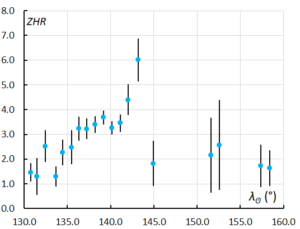
Figure 5 – ZHR Profile of the Kappa Cygnids in 2021 based on Table 2. The “gap” between 145°–151° in λʘ is caused by the Full Moon.
More than 1600 kappa Cygnids were reported on the IMO website. A large amount of data came from observations from one location by a large group of Czech observers with a lot of overlap among their observations. Therefore, not all data from that group has been used because the final result would be greatly influenced by this large group. A good Cp could be calculated for a number of these observers, so only the data from these specific observers were used. We hope that this group will remain active longer and observe more often so that the Cp coefficients for more people can be determined. Ultimately, 820 kappa Cygnids were used for this analysis. For the period from August 3 to 6, an assumed population index r of 2.00 was used, because it is in line with the population index r on August 6 and 8. The result of all calculations can be seen in Table 2 and Figure 5.
The maximum ZHR was reached on the night of 2021 August 15–16. Several observers got individual ZHRs above 6 and reported relatively many bright kappa Cygnids. This can also be seen in the population index r of that night (Table 1). Now this graph alone does not say much about the enhanced activity of the kappa Cygnids. For that we have to compare the activity profile with other years. In this case, 2017 and 2020 were chosen. According to the observations, in 2017 there was certainly no increased kappa Cygnid activity. In 2020 this could also have been the case partly because it was close to the 7-year period of the kappa Cygnids. For this, the observations from 2021 were recalculated again, but now with a fixed population index r. This way, the influence of the population index on the ZHR calculations was the same for all three years. We used a population index r = 2.2, the average r-value. The ZHRs from 2017 and 2020 were then also calculated using the same r-value. Furthermore, exactly the same standards also applied to the data used as mentioned above. The result is Figure 6.
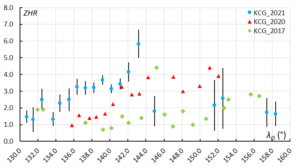
Figure 6 – Combined ZHR profiles based on visual observations of the kappa Cygnids from 2017, 2020 and 2021.
Here we clearly see that the 2021 ZHR profile is the highest with a maximum ZHR of 6 around λʘ = 143° (August 15–16). The ZHR profile for 2020 remains below that of 2021, while 2017 shows the lowest activity. Based on the 2020 ZHR profile, the kappa Cygnids displayed also some increased activity during that year. Therefore, Figure 6 seems to give the result of a successful kappa Cygnid analysis with already increased activity in 2020. However, there are also some very critical comments to be made on basis of this analysis, about the observations. We can make use of the CAMS video network data from 2021 to explain this.
6 Discussion
1 Position and size of the radiant of the kappa Cygnids
In this analysis, the radiant positions from the IMO Meteor Shower Calendar 2021 were used. Problem is that both in right ascension and especially in declination the radiant position of the kappa Cygnids from IMO is very different from the radiant positions according to the CAMS-BeNeLux results. Sometimes the IMO position is more than 15 degrees off. See, for example, Figures 3 and 7. The low activity in combination with the radiant, especially in declination, means significant differences in ZHR if you take a higher or lower declination in the calculations. The accompanying text in the Meteor Shower Calendar does mention that a study by Koseki indicates that there is a large radiant complex in Cygnus, Lyra and Draco (Koseki, 2014). It appears to be best to calculate the mean radiant position from CAMS observations. The result is that the ZHRs will be a bit higher, because the IMO radiant position is always higher in the sky than the radiant positions obtained by CAMS-BeNeLux up to the maximum of the kappa Cygnids.
2 Visual observer’s knowledge of the kappa Cygnid radiant
The above-mentioned point has also a major influence on the observations in the field. Do the observers know the real radiant position? Do the observers know that the radiant is so dispersed in declination? Do they take that into account in the field when classifying, including the influence of zenit attraction? Or do they only use the strict radiant positions in the IMO’s Meteor Shower Calendar for that? If an observer focuses solely on the radiant position in the IMO calendar, and is not aware of the size of the radiant of the kappa Cygnids, especially in the declination, some (most!) kappa Cygnids may be incorrectly classified as sporadics. Especially in the second part of the night, when the radiant is lower at the sky, a kappa Cygnid can quickly be misidentified as sporadic if an observer does not know better. This could explain the more than usual decline in observed numbers of kappa Cygnids during an observation night by several observers, as revealed by the visual analyses. See also point 4: Visual observers see ‘too few’ kappa Cygnids. It is therefore important to adjust the radiant position of the kappa Cygnids in the Meteor Shower Calendar. Figure 7 shows the radiant positions of the KCG between July 19 and August 31, based on CAMS-BeNeLux data from 2021.
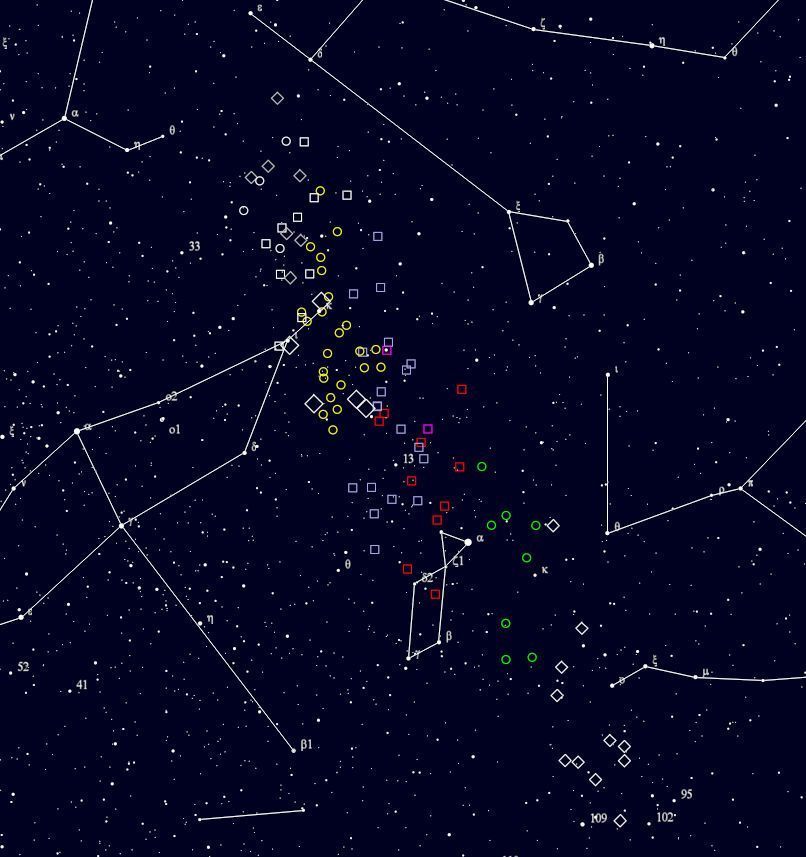
Figure 7 – Radiant drift of the kappa Cygnids between July 19 and August 31, 2021 based on CAMS-BeNeLux data. Legend: White diamonds: period 2021 July 19–25, green circles: 2021 July 25–31, red squares: 2021 August 1–5, lilac squares: 2021 August 5–10, yellow circles: night 2021 August 14–15, white squares: 2021 August 20–21, gray diamonds: 2021 August 24–25 and white circles: 2021 August 28–31. The 5 large white diamonds indicate the radiant positions of the kappa Cygnids captured by the BeNeLux all sky network (Betlem, 2021). See also Figure 8 for more details. Note: these are not all available radiant positions. A maximum of 100 objects could be entered. When choosing the radiants used, the extreme limits of the radiant positions were mainly taken into account.
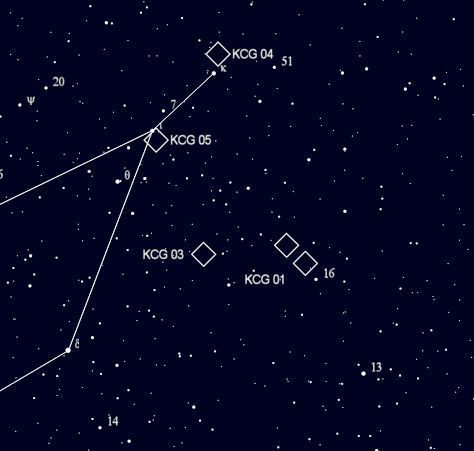
Figure 8 – Overview of the radiant positions of the kappa Cygnids in 2021, found by the BeNeLux all sky network. See also (Betlem, 2021). KCG 01: 2021, August 10, 22h02m36s UT, KCG 02: 2021, August 11, 22h21m06s UT, KCG 03: 2021, August 14, 01h40m43s UT, KCG 04: 2021, August 14, 23h51m47s UT, KCG 05: 2021, August 17, 01h08m11s UT.
3. Increased KCG activity in 2020?
Earlier in this article we already showed that visual observers also observed increased kappa Cygnid activity in 2020 compared to 2017, see Figure 6. So, it is interesting to take a look at CAMS observations in 2017, 2020 and 2021. Visual and CAMS observations can’t be compared one to one. After all, the visual observer only sees part of the activity. The weaker the meteor, the more likely it will be missed. For CAMS we can assume that the largest part will be recorded. For this study, the percentage of kappa Cygnids was determined relative to sporadic activity. The observed sporadic activity was set to 100% for each night, and then the number of kappa Cygnids each night was reported as a percentage of the sporadic activity for that night. In this way and by using the worldwide CAMS data, an attempt was made to rule out the regional weather and growth of the network. The result is presented in Table 3 and Figure 12.
A different picture emerges from this approach. According to CAMS data, the kappa Cygnids were slightly more active in 2020 than in 2017, but it is very marginal if you compare it with the difference between 2017 and 2021. Because in 2021 it is very clear that the activity had increased considerably. But why are visual observers clearly seeing more kappa Cygnids in 2020 than in 2017? In order to find answers to this question, the following research was carried out. In Table 3, the last column activity is the average activity from the Total column multiplied by 1.5. Subsequently, the nights where the average activity was greater than the number in the last column was examined. The higher values are red colored cells. The following conclusions can be drawn from this.
- According to CAMS observations there is not a real maximum during the annual kappa Cygnid activity, such as in 2017.
- The KCG activity in 2020 is only a fraction higher than 2017.
- In 2021, during the increased activity, most activity took place between 11 and 18 August.
Another reason for possible enhanced kappa Cygnid activity in 2020, may be found in another meteor shower, the August Draconids (197#AUD). This meteor shower may also belong to the kappa Cygnid complex (Jenniskens, 2016). These meteors have almost the same speed as the kappa Cygnids and the August Draconids radiant, also extended in declination, lies northeasterly next to the area of the kappa Cygnids radiant. Figures 8 and 9 display the radiant positions of the kappa Cygnids and August Draconids. Therefore, the activity percentage for the August Draconids was also determined relative to the sporadic activity. (Table 3). This calculation shows that the annual activity of the August Draconids is higher than the annual activity of the kappa Cygnids, except when the kappa Cygnids reached their 7-year maximum (see also Table 3).
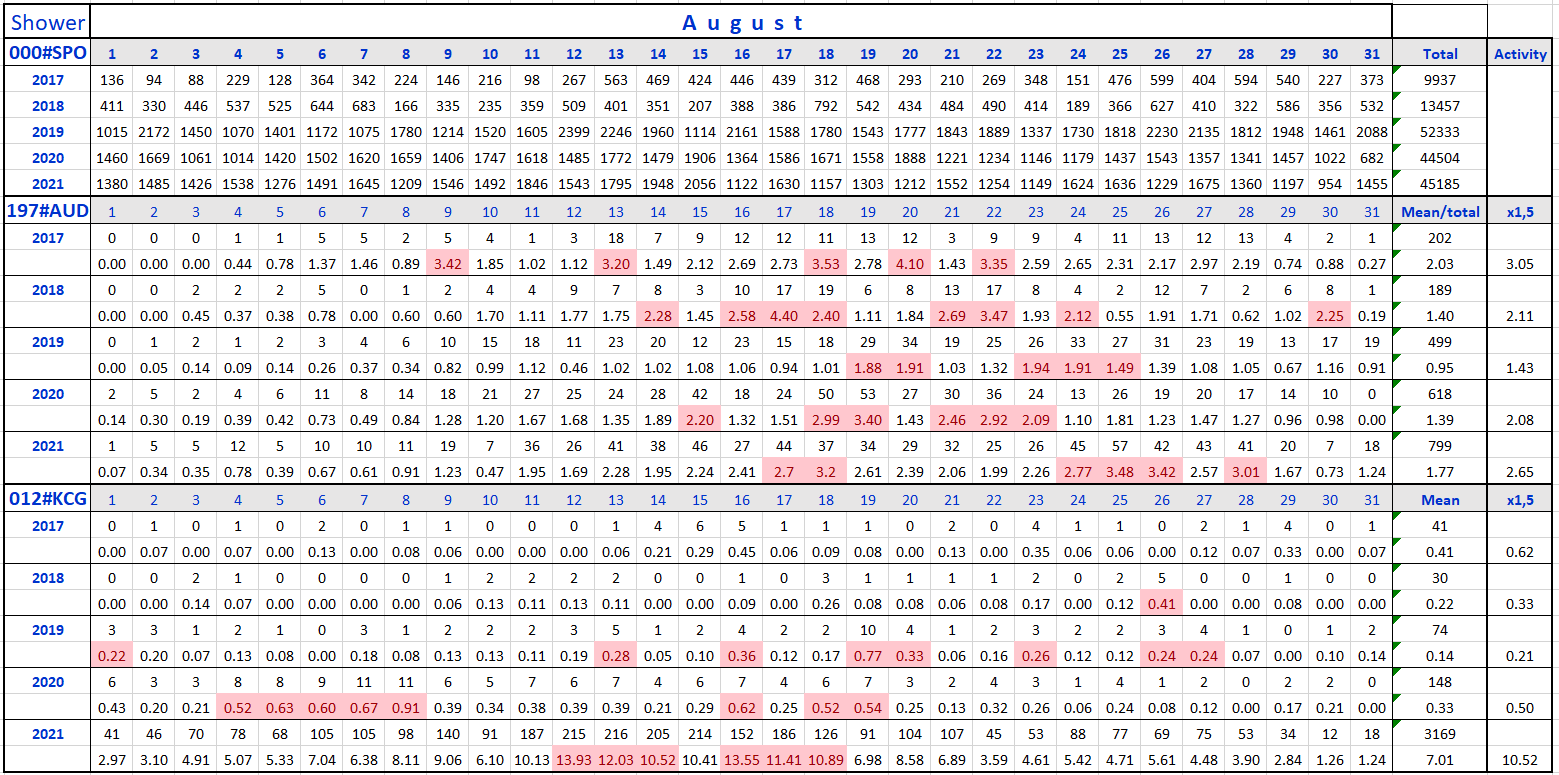
Table 3 – The observed sporadic activity was set to 100% for each night, and then the number of kappa Cygnids each night was reported as a percentage of the sporadic activity for that night. The red cells mark the values that were 1.5× larger than the average value for that year.
In addition, for most observers the kappa Cygnid and August Draconid radiants are ignored because of the dominant Perseids. It seems quite possible that members of the August Draconid meteor shower are mistaken for kappa Cygnids due to the alignment of the radiants and the same characteristic speed. Of course, this also applies to the other years, so in 2021 there may also be some contamination from the August Draconid meteor shower. This problem for visual observers is well illustrated in Figures 9, 10 and 11.
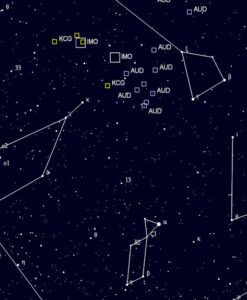
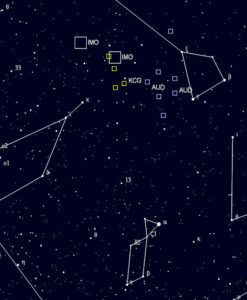
Figure 9 (left) and Figure 10 (right) – Radiant positions of the kappa Cygnids (yellow squares) and Augustus Draconids (pink squares) on 2020 August 10 (Figure 9) and 18–19 (Figure 10). The white large squares represent the IMO kappa Cygnids radiant positions on August 1 (lower) and August 30 (upper).
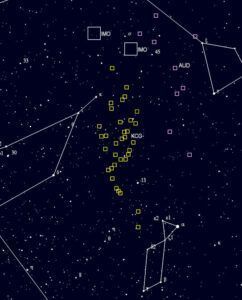
Figure 11 – During the night of 2021, August 10–11, 34 kappa Cygnids and 9 August Draconids were captured by CAMS-BeNeLux. Here are the radiant positions of these meteors shown. Yellow squares are the kappa Cygnids, the lila squares are the August Draconids. It is clear that both meteor showers have an elongated radiant especially in declination. The IMO radiant positions (large white squares) deviate significantly and can lead to problems in the visual classification of kappa Cygnids.
The apparently increased activity in 2020 found from the visual observations is probably caused by a combination of a certain contamination by the August Draconid activity and observations made while using the incorrect radiant positions provided in the IMO’s Meteor Shower Calendar, the latter affecting mainly the period outside the maximum. Around the maximum, the radiant positions according to IMO, seem to agree better with the CAMS observations, so more correct kappa Cygnid classifications may be available around that time. That could also be a reason why visual observers found a maximum around solar longitude 145° (18 August). At that time the radiant position of the IMO corresponds nicely with the CAMS-Benelux data (see Figure 10).
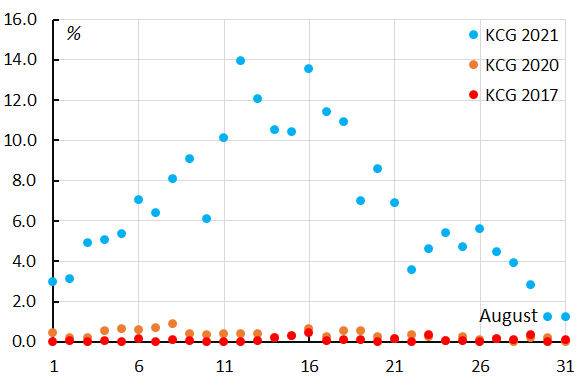
Figure 12 – Percentages of the kappa Cygnids from 2017, 2020 and 2021 plotted for 1–31 August. This graph is based on Table 3 with all data from CAMS worldwide. SPO = 100%, determined each night. In this graph it is clearly visible that in 2020 there was no increased kappa Cygnid activity.
4. Visual observers see ‘too few’ kappa Cygnids
While entering the kappa Cygnid observational data we noticed that almost all observers report relatively too few kappa Cygnids in the second half of the night. For example, between 2021 August 10–15, most observers regularly record kappa Cygnids during the first hours, but very few in the second part of the night. That is of course an anomaly. We suspect that this is due to the kappa Cygnid radiant moving lower in the west/northwest over the night (i.e., increasingly out of view for most observers). At the same time the Perseids appear in increasing numbers. Because of these two effects, observers start to pay most attention to the Perseids. In other words, the Perseid activity predominates and draws all attention away from the kappa Cygnids during the night. This effect appears to be even stronger for observers at lower latitudes. The list of simultaneous kappa Cygnids collected by the CAMS-BeNeLux network shows that the radiant height affects the numbers of kappa Cygnids during the night as expected, but the decrease is not as strong as with the visual observers. It therefore appears that the cause may lie in the two effects described above.
5. During which period are the kappa Cygnids active?
CAMS observations worldwide show that the kappa Cygnids are active since June 20: in 2020 the first one was detected on June 20, in 2021 it was June 22. We must of course take into account that this concerns 1 or 2 kappa Cygnids per date through the very large worldwide network of CAMS. The chances for a visual observer seeing a kappa Cygnid during this period are negligible. With the radiant still in or near the Antihelion radiant, these kappa Cygnids will be recorded as Antihelion. The radiant positions appear to move in the same direction through the sky during the annual as well as the enhanced activity years, but the extent of declination appears to be somewhat smaller during the annual years. During the second and third decade of August, visual observers will also have to deal with the August Draconids, which come from an area near the kappa Cygnid radiant (and may be related). Moreover, the August Draconids have the same characteristics as the kappa Cygnids.
In practice, most observers reported their first kappa Cygnids in late July or early August. It is worthwhile to keep an eye out for them in the coming years.
7 Conclusion
The kappa Cygnids showed an increased activity in 2021 as expected. The visual observations from 2021 could be nicely confirmed by the CAMS observations worldwide. Possible enhanced activity in 2020 found from visual observations could not be confirmed by CAMS observations. The problem here is that there is pollution from the August Draconids, especially in the second and third decade of the month. This really presents problems in determining the ordinary annual activity. This analysis may raise questions. In addition, observers need to be made aware of the actual size of the kappa Cygnid radiant as well as its correct position, especially during the years with enhanced activity. Adjustment of the radiant positions in the IMO Meteor Shower Calendar is highly recommended.
Acknowledgment
Thanks to Michel Vandeputte and Paul Roggemans for carefully reading this article. Paul Roggemans for checking the English. Of course, many thanks go out to all observers who observed the kappa Cygnids in 2021. Without the observers, these analyzes are not possible! The following observers provided data:
Tomasz Adam, Mark Adams, Mina Alizadeh, Pierre Bader, Charlotte Benoit, Orlando Benítez Sánchez, Felix Bettonvil, Rémy Boucher, Steve Brown, Lucas Camargo da Silva, Leonidas Constantinou, Tibor Csorgei, Thomas Daniels, Kolyo Dankov, Sietse Dijkstra, Simon Dijkstra, Julie Dostalova, Marie Dostálová, Radek Drlik, Jaroslav Dygos, Frank Enzlein, Kai Gaarder Kai, Christoph Gerber, Mitja Govedič, Paul Gray, Matthias Growe, Pavol Habuda, Filip Halaska, Martin Halaska, Milada Halaskova, Gabriel Hickel, Lumír Honzík, Klára Horáková, Antal Igaz, Carl Johannink, Javor Kac, Václav Kalaš, Jiri Konecny, Ralf Kosschack, Lazlo Kotel, Vladimir Krejci, Lukas Krejzlik, Katerina Krumpholcova, Kwinta Maciej, Greet & Jan Lembregts, Anna Levin, Robert Liska, Ivana Liskova, Hartwig Luethen, Robert Lunsford, Oleksander Maidyk, Pierre Martin, Bruce McCurdy, Jiří Minář, Koen Miskotte, Jan Mocek, Sirko Molau, István Mátis, Veikko Mäkelä, Jaroslav Navratil, Tomáš Nejdl, Mohammad Nilforoushan, Lovro Pavletic, Jiří Polák, Sasha Prokofyev, David Prudek, Tobias Pudl, Jiří Příbek, Ina Rendtel, Jürgen Rendtel, Janko Richter, Terrence Ross, Stefan Schmeissner, Ivan Sergey, Ulrich Sperberg, Petra Strunk, Tamara Tchenak, Csilla Tepliczky, Jana Thys,Matus Tichy, Snežana Todorović, Ondřej Trnka, George Troullias, Marcella Vaclavikova, Peter van Leuteren, Michel Vandeputte, Hendrik Vandenbruaene, Janko Vasilijević, Martin Vyhnalek, Martina Vyhnálková, Dita Větrovcová, Jan Wagner, Thomas Weiland, Roland Winkler, Anna Wrnatova, Patrick Wullaert, Frank & Sabine Wächter, Jiarui Xiong, Jacub Černý and Čečil Roman.
Also thanks for all CAMS BeNeLux station operators, they are: Hans Betlem (Woold, CAMS 3071, 3072 and 3073), Felix Bettonvil (Utrecht, Netherlands, CAMS 376 and 377), Jean-Marie Biets (Wilderen, Belgium, CAMS 379, 380, 381 and 382), Ludger Boergerding (Holdorf, Germany, RMS 3801), Martin Breukers (Hengelo, Netherlands, CAMS 320, 321, 322, 323, 324, 325, 326 and 327), Giuseppe Canonaco (Genk, RMS 3815, RMS 3818, RMS 3819), Pierre de Ponthiere (Lesve, Belgium, RMS 3816), Bart Dessoy (Zoersel, Belgium, CAMS 397, 398, 804, 805, 806 and 3888), Tammo Jan Dijkema (Eelderwolde, Netherlands, RMS 3198, Dwingeloo, Netherlands, RMS 3199), Jean-Paul Dumoulin, Dominique Guiot and Christian Walin (Grapfontaine, Belgium, CAMS 814 and 815, RMS 3814, RMS 3817), Uwe Glässner (Langenfeld, Germany, RMS 3800), Luc Gobin (Mechelen, Belgium, CAMS 3890, 3891, 3892 and 3893), Tioga Gulon (Nancy, France, CAMS 3900 and 3901), Robert Haas (Alphen aan de Rijn, Netherlands, CAMS 3160, 3161, 3162, 3163, 3164, 3165, 3166 and 3167), Robert Haas (Texel, Netherlands, CAMS 811, 812 and 813), Kees Habraken (Kattendijke, Netherlands, RMS 378), Klaas Jobse (Oostkapelle, Netherlands, CAMS 3031, 3032, 3033, 3034, 3035, 3036 and 3037), Carl Johannink (Gronau, Germany, CAMS 3001, 3002, 3003, 3004, 3005, 3006, 3007, 3008, 3009 and 3010), Reinhard Kühn (Flatzby, Germany, RMS 3802), Hervé Lamy (Dourbes, Belgium, CAMS 394 and 395), Hervé Lamy (Humain Belgium, CAMS 816), Hervé Lamy (Ukkel, Belgium, CAMS 393), Koen Miskotte (Ermelo, Netherlands, CAMS 351, 352, 353 and 354), Tim Polfliet (Gent, Belgium, CAMS 396), Steve Rau (Zillebeke, Belgium, CAMS 3850 and 3852), Paul and Adriana Roggemans (Mechelen, Belgium, RMS 3830 and 3831, CAMS 3832, 3833, 3834, 3835, 3836 and 3837), Hans Schremmer (Niederkruechten, Germany, CAMS 803).
References
Betlem H. (2021). All-Sky nieuws: vuurbollen augustus t/m december 2021″, Radiant 2021-6, p. 89-102.
Denning W.F. (1893). “The August meteors”. Observatory, 16, 317–319.
Jenniskens P. (2006). Meteor Showers and their Parent Comets, Cambridge University Press.
Jenniskens P. (2007). “Kappa Cygnids 2007”. CBET 1055, 2007 September 9, editor Daniel W.E. Green.
Jenniskens P., Vaubaillon J. (2008). “Minor planet 2008 ED69 and the kappa Cygnid meteor shower”. Astronomical Journal, 136, 725–730.
Jenniskens P., Nénon Q., Albers J., Gural P. S., Haberman B., Holman D., Morales R., Grigsby B., Samuels D., Johannink C. (2016). “The established meteor showers as observed by CAMS”. Icarus, 266, 331–354.
Jenniskens P. (2021b). “Enhanced κ-Cygnid (KCG#0012) activity in 2021”. eMetN, 6, 462–463.
Jenniskens P. (2021a). “Kappa Cygnid meteors 2021”. CBET 5014, 2021 August 9, editor Daniel W.E. Green.
Johannink C. (2007). “Zomeraktie te Gronau”. Radiant, Journal of the DMS, 29, 162–167.
Koseki M. (2014). “Various meteor scenes II: Cygnid-Draconid complex (κ-Cygnids)”. WGN, Journal of the IMO, 42, 181–197.
Kronk G.W. (1987). Meteor Showers, a Descriptive Catalogue. Hillside, NJ, Enslow.
Langbroek M. (1993). “Vuurwerk boven de Provence!! De aktiviteiten van het ‘dreamteam’ Rognes”. Radiant, Journal of the DMS, 15, 96–106.
Miskotte K. (1985). “Puimichel (2)”. Radiant, Journal of the DMS, 7, 103–104.
Miskotte K., Rispens B. (1986). “De Perseiden in Puimichel”. Radiant, Journal of the DMS, 8, 80–83.
Miskotte K., ter Kuile C., van Leuteren P., Dijkstra S. (2013). “Perseiden actie vanuit de Provence”. Radiant, Journal of the DMS, 35, 63–70.
Miskotte K. (2020). “De χ Cygniden in 2020: een visuele analyse”. Radiant, Journal of the DMS, 42, 159–161.
Miskotte K. (2021). “The Chi Cygnids (CCY # 757) in 2020, a visual analysis”. eMetN, 6, 540–542.
Rendtel J., Molau S. (2015). “Enhanced kappa-Cygnid activity 2014”. WGN, Journal of the IMO, 43, 43–46.

